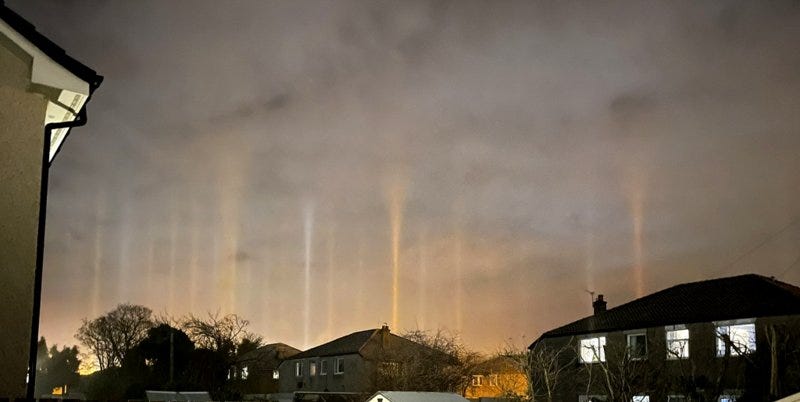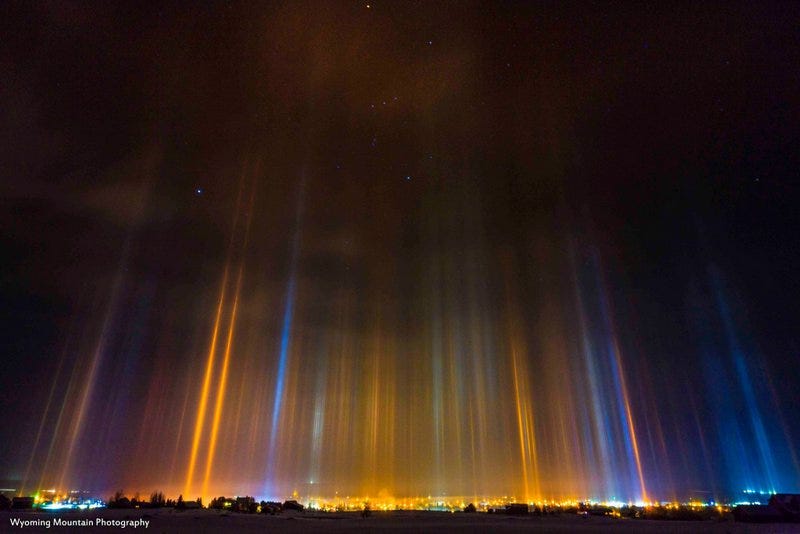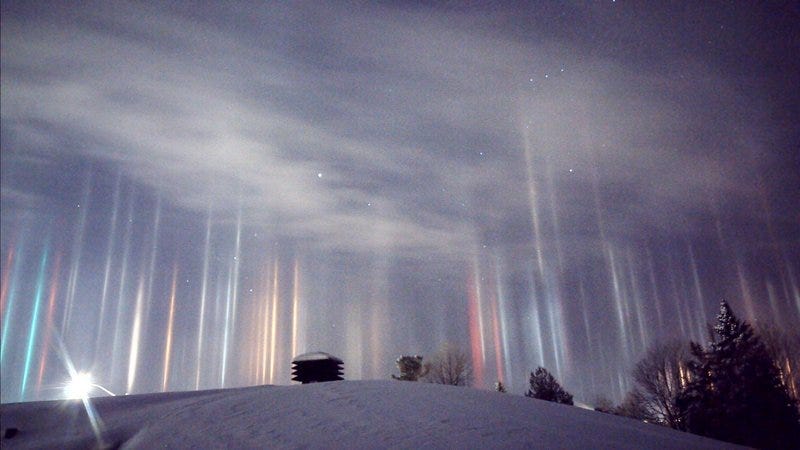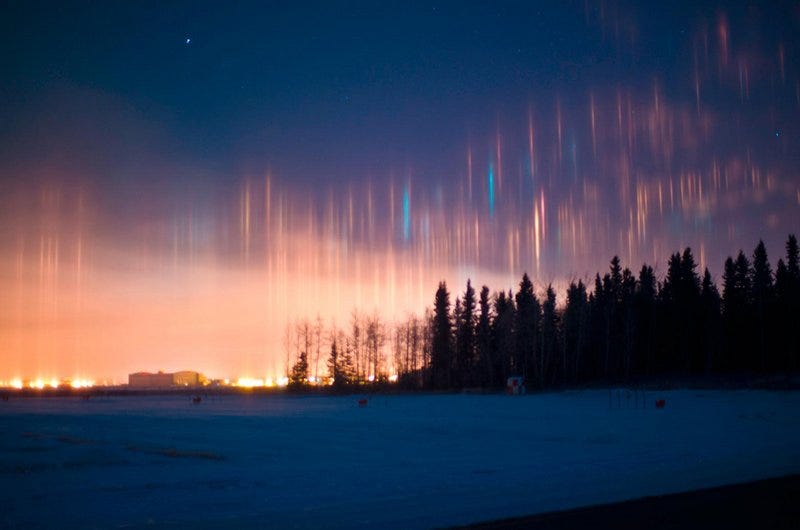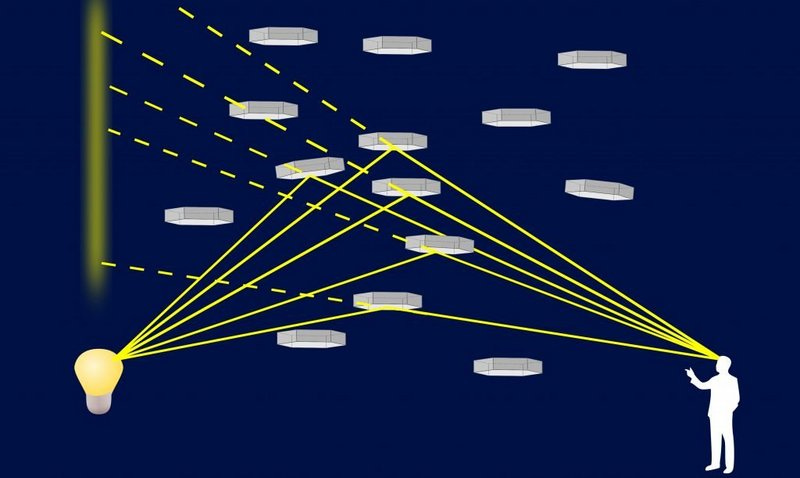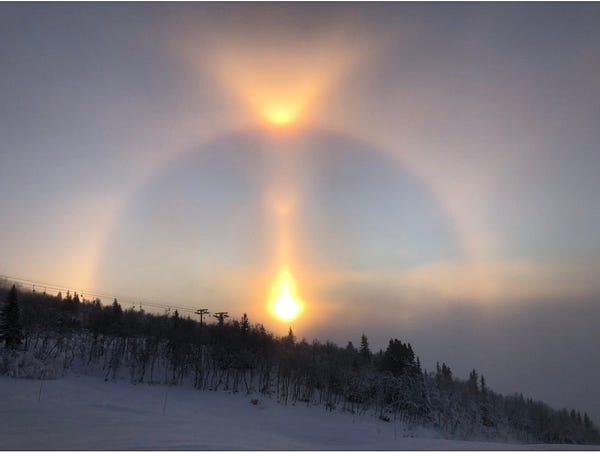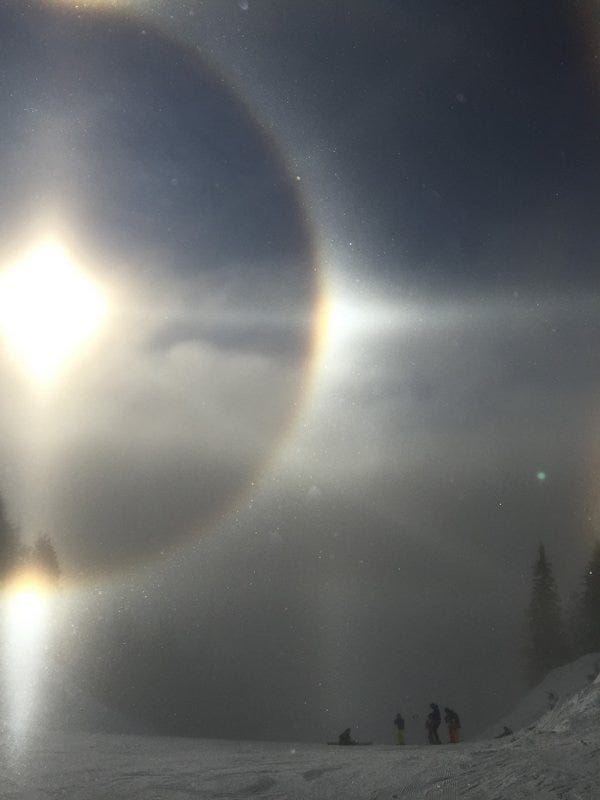Hello! This is Everything Is Amazing, a newsletter about how fun it is to chase your own curiosity until you stumble over something you never knew you didn’t know.
The newsletter’s on a ‘twixt-season break right now - here’s what happened in season 5 and here’s what’s next (plus here, too).
This is the third part of a 6-week roundup of the best stuff so far: one of twelve formerly published pieces that created a bit of buzz when they first went out (the first two are here and here).
This one was particular popular: it was the subject of my first viral Twitter thread at the end of 2021, reaching around 3 million people and generating a lot of delightful (and a scatter of snarky) feedback, as you’ll see later…
So, today, as originally published here, let’s look at the time something exceedingly odd happened in the skies above Glasgow.
One day in earlier January 2021, city resident Steph Nixon took this photo. What the hell…? Some kind of mass celebration with multicoloured spotlights? A critical footie game? Nope, nothing scheduled. So - what was it?
When Steph’s tweet went viral, replies quickly filled up with animated GIFs from War of the Worlds, Independence Day, Star Trek and Rick and Morty. The further it got retweeted, the more imaginative the explanations became:
“Ah, this is a phenomenon not seen for a while now. It's called 'virtuous auroras' . Happens when an overwhelming feeling is inside a group of people.”
I saw nothing about this Twitter kerfuffle at the time, despite living less than 40 miles away. I also didn’t see anything in the sky when I went for my early evening walks.
But that’s not surprising. It’s very hard to see something that isn’t actually there.
One snowy winter’s night four years ago, photographer David Bell saw a similar thing - multicoloured towers of light emerging from the fog outside his window in Pinedale, Wyoming. He grabbed his coat and a tripod for his camera, crunched out into the snow and took this mesmerisingly beautiful image:
Just astounding, right?
Alas, if only these beams of light actually existed.
Another example: check out this video of Olso, from just last week (h/t Ben Stamnes).
Or how about this sight, captured by Timothy Elzinga in Northern Ontario, also in 2017?
Nope. They don’t exist either.
Okay, I’m even annoying myself now. How can something regularly seen by thousands, maybe millions of people worldwide, including multiple people stood in the same place at the same time, be described as “not existing”? And how can it not be there if it shows up on film? What is this, an episode of Most Haunted?
In December 2021 I posted some of these images in a Twitter thread, which started with this tweet:


It went absurdly viral, in a way nothing I’ve posted on Twitter has ever done before - and, of course, I started getting yelled at.
“Of course it exists!”
“You’re stupid. Get off the internet.”
“They’re light pillars, like rainbows. There, saved you a click because these [sic] guy is a pedantic newslettering idiot pushing clickbait coz he doesn't have a life.”
This withering irritation may be part of why it was so widely shared - in which case, I guess I am indeed guilty of using clickbait tactics, aka. “rile everyone up with an outrageous statement.” I guess I’m one of those people! Who knew?
(Possible answer: everyone but me.)
But there’s a scientific argument here to back up my maybe-clickbait - and a deeper scientific truth hinted at, which can be rather uncomfortable to sit with.
Here it is:
All the people on all sides of this argument are correct. These pillars of light, simultaneously and without any contradiction, do and do not exist.
Here’s the bizarre science that backs this up.
When you think you see one of those pillars of light, you’re actually seeing something like this (above).
As it gets colder, water in the air turns to ice crystals, which can hover near to the ground in glittering clouds with the beautiful nickname of diamond dust. The majority of these crystals are hexagonal, with a flat, reflective surface on both sides - and as they slowly drift towards the ground, many of them align themselves horizontally.
Enter a distant light source (the bulb in the above diagram). A street-light, a neon sign, a spotlight at a football stadium. Any light bright enough to travel miles, until it glints off those ice crystals in the air, and reflects down into your eyes…
Because of the way these reflections work, the light reflecting at just the right angle to hit your retinas is from crystals suspended more or less at the same distance from you (roughly halfway between your eyes and the distant light source) - but at different altitudes, like different storeys in the same house.
The illusion this creates - see the dotted lines above - is that of a column of light, hovering near or above the original source of light on the ground. It’s like how the light from a real object being bent by cold air into a superior mirage [more about that in a few days!], making our brains assume we’re seeing a ship floating in the air - when what we’re really seeing is light behaving in a way we’re so profoundly not used to seeing that it plays a trick on our minds.
A light pillar exists because it’s a very real optical phenomenon you can see, presumably along with any species capable of seeing in the same visual spectrum we do. Dogs, for example. (I think dogs would much prefer light pillars as alternatives to fireworks.)
And it’s similarly real because it’s made of very real photons - well, as much as photons can be considered real. If you want to start a fight between two physicists, this might be a good topic to steer them onto.
Yet it’s also not real because it’s not there. It’s virtual. There is no pillar hanging in the sky, as anyone standing anywhere else will attest, including the people directly underneath “it”. You might as well say a rainbow is real (which of course it is, but also isn’t).
When I tried to introduce the science in these terms, it’s fair to say it didn’t sit well with a lot of people:

A lot of this may be down to my failings as a communicator. But I think it’s also because an optical illusion is a False Dilemma (which I wrote about here) - the limiting fallacy that forces us to choose between two options when there are credible arguments for both being right.
These kinds of situations crop up in modern science all the time: for example, the staggering oddness of wave-particle duality, which Einstein explained like this:
It seems as though we must use sometimes the one theory and sometimes the other, while at times we may use either. We are faced with a new kind of difficulty. We have two contradictory pictures of reality; separately neither of them fully explains the phenomena of light, but together they do.
Accepting this kind of down-to-the-bone uncertainty is really damn hard. Our minds aren’t cut out for it.
But, rather disturbingly, it may be how everything is actually wired up. It’s like the fabric of existence itself is refusing to come up with any hard answers and is, as Jonny Miller would say, just sitting comfortably with all the questions.
(A common reason some folk don’t like the idea of hard science is that they worry it’ll explain everything in depressingly mechanical terms & rob the world of all its mystery. The reality: it might go in the other direction, and show that everything is so bafflingly non-intuitive to human minds that we’ll never be able to get our heads round it!)
OK. Backing away from this yawning abyss of theoretical lunacy, let’s return to the very real/unreal world of light pillars.
Hey, aren’t they just like those halos you sometimes see around the sun? Isn’t that the same principle?
Bang on, mate.
A parhelion, better known as a sundog, is a light pillar in a different form: reflections from ice crystals creating an illusory structure hanging in the air that can only be seen from one viewpoint. And I have it on good authority that experiencing these things in person is just overwhelming.
Take this whopper that followed my friend Antonia across a mountainside in 2015:
(Can you see the glitter of the ice-crystals hanging in the air? Fabulous.)
And staying with the Sun, and adding in the Moon:




So, when summer’s done and the holidays arrive along with the bitter cold, it may feel like a good idea to stay in bed, or sit swaddled in fleecy things by the fire, at least until the sun is as close to overhead as it gets at the extreme end of the year. Every day may feel like Crappy Netflix Movie 1, Outdoors 0…
But ‘tis the season of deep optical weirdness - and as the temperature plummets, you might see something that’ll remind you that the real world is far stranger than it looks (and occasionally looks far stranger than it actually is).
Brave the cold, keep your eyes open, and you might see something impossible. Wouldn’t that be a thing to finish the year with?
If you thought that was odd, try this paywalled piece on the two enormous “trees of fire” deep under Africa and the Pacific, on a scale that beggars belief.
From now until September, all paid subscriptions to Everything Is Amazing are 10% off.
That’d give you access to all those paywalled articles, to my upcoming non-fiction storytelling course, to chapters of my first book How To Be Rained On when they’re ready, and a personal ‘curiosity call’ to motivate you to chase your own nerdiness in a similar way, as I explained here.
When that light pillars Twitter thread blew up and I got 600 newsletter subscribers (!) in three days (!!!), that was the moment I felt like I could find an audience for this odd little newsletter. Now it’s my fulltime job, I have big plans - and reader subscriptions are my sole source of income for it (no ads!)…
So if you’ve enjoyed any part of Everything Is Amazing, a paid subscription at any level is the best way to help me keep this thing alive.
Click below to sign up with a 10% discount. Thank you!




